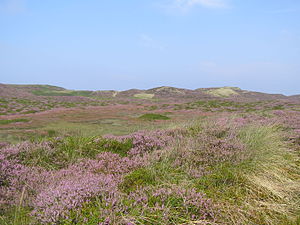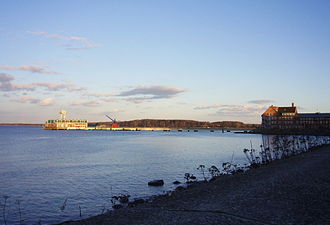
A | B | C | D | E | F | G | H | CH | I | J | K | L | M | N | O | P | Q | R | S | T | U | V | W | X | Y | Z | 0 | 1 | 2 | 3 | 4 | 5 | 6 | 7 | 8 | 9
Schleswig-Holstein
| |
|---|---|
 | |
| Coordinates: 54°28′12″N 9°30′50″E / 54.47000°N 9.51389°E | |
| Country | Germany |
| Capital | Kiel |
| Government | |
| • Body | Landtag of Schleswig-Holstein |
| • Minister-President | Daniel Günther (CDU) |
| • Governing parties | CDU / Greens |
| • Bundesrat votes | 4 (of 69) |
| • Bundestag seats | 28 (of 736) |
| Area | |
| • Total | 15,763.17 km2 (6,086.19 sq mi) |
| Population (4 January 2022)[1] | |
| • Total | 2,920,850 |
| • Density | 190/km2 (480/sq mi) |
| GDP | |
| • Total | €112.755 billion (2022) |
| • Per capita | €41,925 (2022) |
| Time zone | UTC+1 (CET) |
| • Summer (DST) | UTC+2 (CEST) |
| ISO 3166 code | DE-SH |
| Vehicle registration | formerly: S (1945–1947), SH (1947), BS (1948–1956)[3] |
| NUTS Region | DEF |
| HDI (2018) | 0.924[4] very high · 13th of 16 |
| Website | schleswig-holstein.de |
Schleswig-Holstein (pronounced [ˌʃleːsvɪç ˈhɔlʃtaɪn] ; Danish: Slesvig-Holsten [ˌsle̝ːsvi ˈhʌlˌste̝ˀn]; Low German: Sleswig-Holsteen; North Frisian: Slaswik-Holstiinj; English: Sleswick-Holsatia[5]) is the northernmost of the 16 states of Germany, comprising most of the historical Duchy of Holstein and the southern part of the former Duchy of Schleswig. Its capital city is Kiel; other notable cities are Lübeck and Flensburg. It covers an area of 15,763 km2 (6,086 sq mi), making it the 5th smallest German federal state by area (including the city-states). Historically, the name can also refer to a larger region, containing both present-day Schleswig-Holstein and the former South Jutland County (Northern Schleswig; now part of the Region of Southern Denmark) in Denmark.
Between 500 and 1200, Schleswig was an integral part of Denmark, but during the 12th century, Duke Abel of Schlewig came into conflict with his brother King Eric IV. Abel managed to gain autonomy from his brother, making Schleswig an autonomous duchy. Later, Abel had Eric assassinated and seized the throne. Despite this, Schleswig remained an autonomous duchy within the Kingdom, setting the stage for future conflicts. Beginning in 1460, both Schleswig and Holstein, were ruled together by the Danish king, who acted as the duke of both regions. Holstein being a duchy within the Holy Roman Empire created a situation where the Danish king was sovereign of Denmark but also a duke within the Holy Roman Empire. In the 19th century, fueled by nationalism both Danes and Germans claimed Schleswig-Holstein. The Germans wanted both Schleswig and Holstein to separate from Denmark and join the German Confederation, whereas the Danes wanted to reintegrate Schleswig with the Kingdom of Denmark while keeping Holstein as an autonomous duchy. The resulting long-term political and territorial dispute was known as the Schleswig-Holstein Question. Holstein was entirely German-speaking, while Schleswig was predominantly Danish-speaking until the late 1700 and early 1800s. During this period, a linguistic shift began in southern Schleswig, transitioning from Danish to German. This meant that Schleswig was linguistically divided with a Danish-speaking north and a German-speaking south. In 1848, Denmark tried to formally reintegrate Schleswig into the Kingdom. The German-speaking Schleswig-Holsteiners rebelled, supported by Prussia and the German Confederation, thus starting the First Schleswig War. Against the odds, Denmark emerged victorious. However, pressured by the great powers led by the Russian Tsar, Denmark was not permitted to reintegrate Schleswig despite winning the war. The reasoning was that the Russian Tsar wanted to maintain the current European order, leading to the signing of the 1852 London Protocol. Sadly, this protocol did not offer any solution to the problem but only maintained the status quo. In 1864, Denmark tried again to formally reintegrate Schleswig, which resulted in the Second Schleswig War. This time, Prussia and Austria utterly defeated the Danes and shared the territory between them. The Austrians administered Holstein, while Prussia governed Schleswig. War broke out between them in 1866, called the Austro-Prussian War. Prussia emerged victorious and annexed Holstein in 1867. Around 50 years later, after The German Empires defeat in World War I, the Allies mandated the return of Schleswig to Denmark, while France advocated for the new border to extend as far south as the Kiel Canal. Denmark lead by Carl T. Zahle and the Social Liberal Party wanted to find a solution to the Schleswig question that would not provoke the Germans and potentially lead to future conflicts, fearing a repetition of the Second Schleswig War. They suggested deciding the matter through plebiscites, leading to the 1920 Schleswig plebiscites, which resulted in the return of the Danish-speaking North Schleswig to Denmark.
After World War II, the British and Soviets offered Denmark South Schleswig, in what would be called the de:Septembernote Denmark's then Prime Minister, the Liberal Party's Knud Kristensen, enthusiastically accepted the offer. A survey showed that 75% of the Danish population supported the incorporation, 500,000 signatures had been collected in support of it and The Danish South Schleswig Association had sent the government a formal request for incorporation. However, the dominating Social Liberal Party feared that Denmark might again face wars like the two Schleswig Wars once Germany recovered from World War II. Given that the Germans had conquered Denmark in six hours during the German invasion of Denmark (1940), they believed Denmark would not stand a chance in such a scenario. Therefore, they pressured the Prime Minister to call for new elections, where the Liberal Party did not secure enough mandates to form a government. The Social Democrats won the election with a minority government and could not gather enough mandates for the incorporation of South Schleswig. This outcome created an outrage within the danish population and was considered a scandal. Realizing that the incorporation of South Schleswig was not feasible, the new government chose to proclaim that the 1920 plebiscites would stand and the borders would remain unchanged, opting instead for cooperation with the Germans. Rather than altering the border, the new government chose to support the Danish minority in South Schleswig with financial aid, a support that continues to this day. The Social Liberal Party, blamed for the lost opportunity of South Schleswig's reunification with Denmark, would never again see the influence they had prior to this incident and remains a smaller and less influential party to this day.
Today, Schleswig-Holstein's economy is known for its agriculture, such as its Holstein cows. Its position on the Atlantic Ocean makes it a major trade point and shipbuilding site; it is also the location of the Kiel Canal. Its offshore oil wells and wind farms produce significant amounts of energy. Fishing is a major industry, and the basis of its distinctive unique local cuisine. It is a popular tourist destination for Germans and tourists across the globe.
History
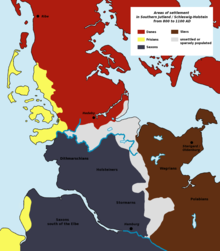
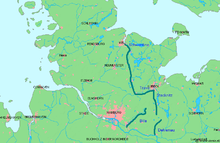
The term "Holstein" derives from Old Saxon Holseta Land, (Holz means wood in modern Standardized German; holt is a now-archaic English word for woods.) Originally, the term referred to the central of the three Saxon tribes north of the River Elbe: Tedmarsgoi (Dithmarschen), Holstein and Sturmarii (Stormarn). The area inhabited by the tribe of the Holsts lay between the Stör River and Hamburg; after Christianization, their main church was in Schenefeld. Saxon Holstein became a part of the Holy Roman Empire after Charlemagne's Saxon campaigns in the late eighth century. Beginning in 811, the northern border of Holstein (and thus of the Empire) was the River Eider.
The term "Schleswig" originally referred to the city of Schleswig. The word Schleswig is a German transliteration of the Danish word Slesvig, which consists of two words: Schlei and vig. The Schlei refers to the river at which the city lies, and vig means "inlet" or bay. Schleswig therefore means (in Danish): "The bay at the river Schlei". The Schlei is known as Slien in Danish and is believed to have been used only for the inner Slien (the Great and Little Bay near the city of Schleswig). The word is thought to be related to Slæ, which means reeds and aquatic plants found in this area.
The Duchy of Schleswig, or Southern Jutland, was originally an integral part of Denmark, but in medieval times was established as a fief under the control of the Kingdom of Denmark, having the same relationship with the Danish Crown as, for example, Brandenburg or Bavaria had with the Holy Roman Emperor. Around 1100, the Duchy of Saxony gave Holstein to Count Adolf I of Schauenburg.
Duchies in the Danish realm
Schleswig and Holstein have at different times belonged in part or completely to either Denmark or Germany, or have been virtually independent of both nations. Schleswig was never part of Germany until after the Second Schleswig War in 1864. But for many centuries, the king of Denmark was both a Danish Duke of Schleswig and a German Duke of Holstein. Essentially, Schleswig was either integrated into Denmark or was a Danish fief, and Holstein was a German fief and once, long before that, a sovereign state. Both were ruled for several centuries by the kings of Denmark. In 1721, all of Schleswig was united into a single duchy under the king of Denmark, and the great powers of Europe confirmed in an international treaty that all future kings of Denmark should automatically become dukes of Schleswig: consequently, Schleswig would always follow the order of succession that applied in the Kingdom of Denmark.
Following the Protestant Reformation, German was established as the language of commerce, administration, education, and clergy in Schleswig despite the population being ethnically Danish. This was because Schleswig were managed by the German Chancellery, in Kiel, which was later renamed the Schleswig-Holstein Chancellery in 1806. Therefore, Danes were sent to Kiel for their education instead of Copenhagen, where they received their education in German rather than their native Danish. As a result, Danish students, future administrators, clergy, and educators were taught in German and continued to use the language throughout their professional lives.
In 1814, mandatory schooling was instituted, and was taught in German. This created generations of Danish children who learned German from an early age. Their schooling was conducted in German, they heard sermons in German, and when they grew up, their interactions with the administration and business were conducted in German. Additionally, if Danes didn't learn German, they couldn't communicate with the administration, which often cared little if the citizens were able to understand them. Therefore, if the Danes weren't able to speak German, they were effectively frozen out of any official matters. As a result, a language shift slowly began forming in South Schleswig and gradually spread north, which alarmed Copenhagen. The Danish authorities started taking countermeasures to halt the language shift by banning German in all official matters in Schleswig, which only served to create tensions between Danes and Germans. This language strife significantly contributed to shaping the inhabitants' national sentiments during a time of national unrest in Europe. It is also during this period that we see surname changes, such as from Jørgensen to Jürgensen or Nielsen to Nilsen, in South Schleswig. By the time of the First Schleswig War, one-third of Schleswig and half of South Schleswig spoke German as their first language. By the time of the Second Schleswig War in 1864, half of Schleswig and the vast majority of South Schleswig spoke German as their first language.
Schleswig-Holstein Question
The German national awakening that followed the Napoleonic Wars gave rise to a strong popular movement in Holstein and Southern Schleswig for unification with a new Prussian-dominated Germany. This development was paralleled by an equally strong Danish national awakening in Denmark and Northern Schleswig. This movement called for the complete reintegration of Schleswig into the Kingdom of Denmark and demanded an end to discrimination against Danes in Schleswig. The ensuing conflict is sometimes called the Schleswig-Holstein Question. In 1848, King Frederick VII of Denmark declared that he would grant Denmark a liberal constitution and the immediate goal of the Danish national movement was to ensure that this constitution would give rights to all Danes, i.e. not only to those in the Kingdom of Denmark, but also to Danes (and Germans) living in Schleswig. Furthermore, they demanded protection for the Danish language in Schleswig (the dominant language in almost a quarter of Schleswig had changed from Danish to German since the beginning of the 19th century).
A liberal constitution for Holstein was not seriously considered in Copenhagen, since it was well known that the political élite of Holstein were more conservative than Copenhagen's. Representatives of German-minded Schleswig-Holsteiners demanded that Schleswig and Holstein be unified and allowed its own constitution and that Schleswig join Holstein as a member of the German Confederation. These demands were rejected by the Danish government in 1848, and the Germans of Holstein and Southern Schleswig rebelled. This began the First Schleswig War (1848–51), which ended in a Danish victory at Idstedt.
In 1863, conflict broke out again when Frederick VII died without legitimate issue. According to the order of succession of Denmark and Schleswig, the crowns of both Denmark and Schleswig would pass to Duke Christian of Duchy of Glücksburg, who became Christian IX. The transmission of the duchy of Holstein to the head of the (German-oriented) branch of the Danish royal family, the House of Augustenborg, was more controversial. The separation of the two duchies was challenged by the Augustenborg heir, who claimed, as in 1848, to be rightful heir of both Schleswig and Holstein. The promulgation of a common constitution for Denmark and Schleswig in November 1863 prompted Otto von Bismarck to intervene and Prussia and Austria declared war on Denmark. This was the Second War of Schleswig, which ended in Danish defeat. British attempts to mediate in the London Conference of 1864 failed, and Denmark lost Schleswig (Northern and Southern Schleswig), Holstein, and Lauenburg to Prussia and Austria.
Province of Prussia
Contrary to the hopes of German Schleswig-Holsteiners, the area did not gain its independence, but was annexed as a province of Prussia in 1867. Also following the Austro-Prussian War in 1866, section five of the Peace of Prague stipulated that the people of Northern Schleswig would be consulted in a referendum on whether to remain under Prussian rule or return to Danish rule. This condition, however, was never fulfilled by Prussia. During the decades of Prussian rule within the German Empire, authorities attempted a Germanisation policy in the northern part of Schleswig, which remained predominantly Danish. The period also meant increased industrialisation of Schleswig-Holstein and the use of Kiel and Flensburg as important Imperial German Navy locations. The northernmost part and west coast of the province saw a wave of emigration to America, while some Danes of North Schleswig emigrated to Denmark.
Plebiscite in 1920
Following the defeat of Germany in World War I, the Allied powers arranged a plebiscite in northern and central Schleswig. The plebiscite was conducted under the auspices of an international commission which designated two voting zones to cover the northern and south-central parts of Schleswig. Steps were taken to also create a third zone covering a southern area, but zone III was cancelled again and never voted, as the Danish government asked the commission not to expand the plebiscite to this area.
In zone I covering Northern Schleswig (10 February 1920), 75% voted for reunification with Denmark and 25% voted for Germany. In zone II covering central Schleswig (14 March 1920), the results were reversed; 80% voted for Germany and just 20% for Denmark. Only minor areas on the island of Föhr showed a Danish majority, and the rest of the Danish vote was primarily in the town of Flensburg.[6]

| Electorate | German name | Danish name | For Germany | For Denmark | ||
| percent | votes | percent | votes | |||
| Zone I (Northern Schleswig), 10 February 1920 | 25.1 % | 25,329 | 74.9 % | 75,431 | ||
| District of | Hadersleben | Haderslev | 16.0% | 6,585 | 84.0% | 34,653 |
| Town of | Hadersleben | Haderslev | 38.6% | 3,275 | 61.4% | 5,209 |
| District of | Apenrade | Aabenraa | 32.3% | 6,030 | 67.7% | 12,653 |
| Town of | Apenrade | Aabenraa | 55.1% | 2,725 | 44.9% | 2,224 |
| District of | Sonderburg | Sønderborg | 22.9% | 5,083 | 77.1% | 17,100 |
| Town of | Sonderburg | Sønderborg | 56.2% | 2,601 | 43.8% | 2,029 |
| Town of | Augustenburg | Augustenborg | 48.0% | 236 | 52.0% | 256 |
| Northern part of District of | Tondern | Tønder | 40.9% | 7,083 | 59.1% | 10,223 |
| Town of | Tondern | Tønder | 76.5% | 2,448 | 23.5% | 750 |
| Town of | Hoyer | Højer | 72.6% | 581 | 27.4% | 219 |
| Town of | Lügumkloster | Løgumkloster | 48.8% | 516 | 51.2% | 542 |
| Northern part of District of | Flensburg | Flensborg | 40.6% | 548 | 59.4% | 802 |
| Zone II (Central Schleswig), 14 March 1920 | 80.2 % | 51,742 | 19.8 % | 12,800 | ||
| Southern part of District of | Tondern | Tønder | 87.9% | 17,283 | 12.1% | 2,376 |
| Southern part of District of | Flensburg | Flensborg | 82.6% | 6,688 | 17.4% | 1,405 |
| Town of | Flensburg | Flensborg | 75.2% | 27,081 | 24.8% | 8,944 |
| Northern part of District of | Husum | Husum | 90.0% | 672 | 10.0% | 75 |
On 15 June 1920, Northern Schleswig officially returned to Danish rule. The Danish/German border was the only one of the borders imposed on Germany by the Treaty of Versailles after World War I that was never challenged by Adolf Hitler.
In 1937, the Nazis passed the so-called Greater Hamburg Act (Groß-Hamburg-Gesetz), where the nearby Free and Hanseatic City of Hamburg was expanded, to encompass towns that had formerly belonged to the Prussian province of Schleswig-Holstein. To compensate Prussia for these losses (and partly because Hitler had a personal dislike for Lübeck[7]), the 711-year-long independence of the Hansestadt Lübeck came to an end, and almost all its territory was incorporated into Schleswig-Holstein.

State of Federal Germany
After World War II, the Prussian province Schleswig-Holstein came under British occupation. On 23 August 1946, the military government abolished the province and reconstituted it as a separate Land.[8]
Due to the forced migrations of Germans between 1944 and 1950, Schleswig-Holstein took in almost a million refugees after the war, increasing its population by 33%.[9] A pro-Danish political movement arose in Schleswig, with transfer of the area to Denmark as an ultimate goal. This was supported neither by the British occupation administration nor the Danish government. In 1955, the German and Danish governments issued the Bonn-Copenhagen Declarations confirming the rights of the ethnic minorities on both sides of the border.[10] Conditions between the nationalities have since been stable and generally respectful.
Geography
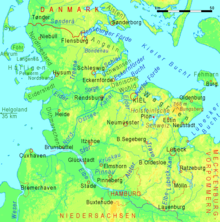
Schleswig-Holstein lies on the base of Jutland Peninsula between the North Sea and the Baltic Sea. Strictly speaking, "Schleswig" refers to the German Southern Schleswig (German: Südschleswig or Landesteil Schleswig, Danish: Sydslesvig), whereas Northern Schleswig is in Denmark (South Jutland County, Region of Southern Denmark). The state of Schleswig-Holstein further consists of Holstein, as well as Lauenburg and the formerly independent city of Lübeck.
Schleswig-Holstein borders Denmark (Southern Denmark) to the north, the North Sea to the west, the Baltic Sea to the east, and the German states of Lower Saxony, Hamburg, and Mecklenburg-Vorpommern to the south.
In the western part of the state, the lowlands have virtually no hills. The North Frisian Islands, as well as almost all of Schleswig-Holstein's North Sea coast, form the Schleswig-Holstein Wadden Sea National Park (Nationalpark Schleswig-Holsteinisches Wattenmeer) which is the largest national park in Central Europe.
The Baltic Sea coast in the east of Schleswig-Holstein is marked by bays, fjords, and cliff lines. Rolling hills (the highest elevation is the Bungsberg at 168 metres or 551 feet) and many lakes are found, especially in the eastern part of Holstein called the Holstein Switzerland and the former Duchy of Lauenburg (Herzogtum Lauenburg). The longest river besides the Elbe is the Eider.
Schleswig-Holstein has the lowest quota of forest covered area, it is only 11.0% (national average 32.0%), which is even lower than in the city-states of Hamburg and Bremen.[11]
The German Islands of Sylt, Föhr, Pellworm, Amrum, Heligoland and Fehmarn are part of Schleswig-Holstein, with the latter being the largest and the only Island of Schleswig-Holstein located on the east coast.[12] Heligoland is Germany's only high-sea island.[12]
-
Geest (Island Sylt)
-
Seestermüher Marsh
-
Eckernförde Bay
-
Wadden Sea
-
Schleswig-Holsteinische Schweiz
-
Kieler Förde
Administration
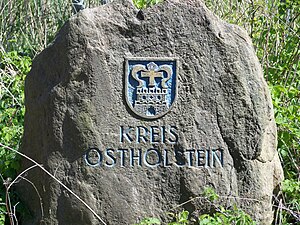

Administrative Division
Schleswig-Holstein is divided into 11 Kreise (Districts) and four Kreisfreie Städte (Urban Districts).



